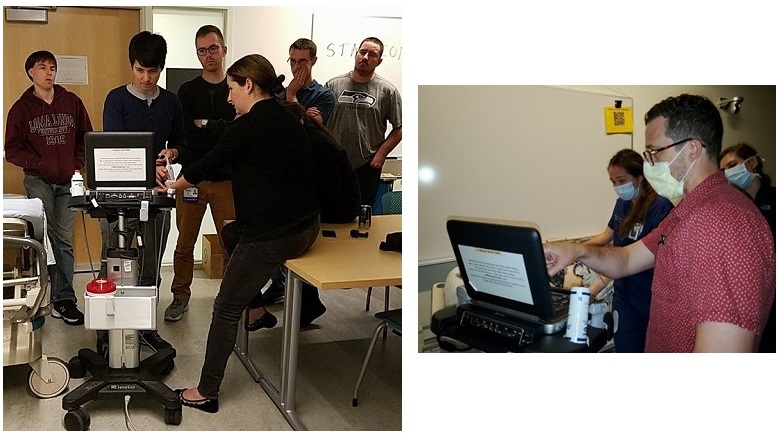Rotations

Overview
Many residency programs have 4-week rotations, culminating into 13 block rotations for the year with clinic time taken out of the wards and consult time primarily. Given our focus on resident education and the need to train in a changing healthcare environment, we made the innovative X+Y change in how we deliver education and training 12 years ago and have continued to make changes to improve the overall system.
Healthcare and residency education continue to change at a rapid pace and in order to prepare residents for their future careers, we believe in thinking creatively about the future and what will be needed to achieve the goal of being exceptional physicians. Thus, we are in a multi-year strategic planning and residency redesign process, involving residents, faculty, leadership, and patients. We look forward to sharing more of where we are in the process and how you can become part of our exciting journey.
General Concepts
- Our inpatient rotations – wards and ICU – are almost always 3 weeks in duration.
- Every fourth week is dedicated to outpatient medicine consisting of primary care continuity clinics and specialty clinics.
- The week-long clinic block also has two half-day educational seminars that focus on primary care ambulatory topics, practice based learning and improvement, ambulatory report, and evidence-based medicine skill-building.
- The PGY2 and PGY3 residents also have the option of choosing a secondary continuity clinic, usually focused on post-residency career plans such as fellowships (e.g., choosing a specialty cardiology clinic).
- Residents will always have a weekend off prior to starting a clinic week; thus, ensuring a weekend off a month in addition to the weekly day off.
Outpatient Concepts
- Most physicians, specialty or generalist, spend a great portion of their time in clinic. In choosing a 3+1 schedule, clinic time is focused into one week rather than dispersed throughout a month.
- Inpatient and outpatient experiences are separated so residents are allowed to fully immerse themselves in patient care and education and to avoid interruptions from other rotations such as the wards on consult services.
- The residents are divided into firms (~25 residents/firm) so the clinic patients have consistent care by the same group of residents. The firm system also allows clinic personnel to know exactly which residents will be in clinic on the following + 1 week. This knowledge facilitates a more organized and patient focused transition of care from week to week.
- Firms also allow residents to develop a team based interprofessional practice model approach to outpatient care.
- There is a guarantee of having a weekend off at the end of 3-week rotations and before beginning the clinic week.
Inpatient Concepts
- We have developed similar symmetry at the University and VAMC wards in order to reduce transitions for residents and interns and make it easier to understand the two different systems.
- Both systems function in a drip model approach (small number of admissions per day); our prior system was a bolus model (high number of admits every few days) which we felt was not as conducive to learning with the extremes that occur in admissions and discharges. The drip model approach also allows more consistent care of patients by all members of the team.
- Consistent opportunity for radiology case conference teaching and learning (University).
- Both systems have face to face sign-out between the teams and night float, which decreases transitions of care and improves overall quality of transmitting information.
- Elimination of educational and emotional pull of clinic during ward time.
- Restructuring of educational conferences to improve process and flow of care for the patients and the teams (see educational conference changes section).
- Increased opportunity for coordinated case management rounds with all members of the healthcare team (physical therapy, pharmacy, nutrition, social work, nursing).
Inpatient Service Facilities
OHSU
We have 6 general medicine ward teams who accept and admit patients in a dip model, allowing more consistent care of patients over time. A night float team is available 6 nights of the week with the remaining one night covered by one of the six general medicine ward teams (12 hour night shift).
The MICU consists of faculty from the Pulm Critical Care Division and serve as attendings for the MICU teams. PCCM and Critical Care fellows are present in the hospital 24/7 to provide support and assistance to the ICU teams and for patients requiring evaluation and possible admission to the ICU from the wards.
Portland VA Medical Center
At the Portland VA Medical Center, four general medicine teams admit and accept patients in a drip model similar to the University wards. A night float team is available 6 nights of the week with the remaining night covered by one of the four general medicine ward teams (~24 hour shift). Attendings are full-time hospitalist or general medicine staff physicians. Each team has a cap of 14 patients. There is a combined team of 4 residents and 4 interns responsible for the combined MICU service. Each team takes turns serving as the night team with day call staggered in a drip model.
The VA ICU consists of 4 residents and 3 interns who are responsible for the MICU and CCU service at the VA. Team members serve as the night team for several days in a row (5-6 nights depending on the team), with a 2-day transition before returning to days. A PCCM or Critical Care fellow is available until 10pm and will remain if needed or can be called in for urgent issues.
Inpatient Conferences & Rounds
Each ward and ICU team makes daily work rounds. Our faculty conducts attending rounds seven days per week. Residents on wards are expected to attend the following teaching conferences:
- Noon Report (formerly morning report) in their respective hospital
- Tuesday morning Medical Grand Rounds (OHSU)
- Noon conferences
In the University and VA ICU, daily didactics are conducted by either faculty or fellows with curriculum specific for the ICU.
At OHSU, ward teams review radiographic studies with the Department of Radiology Chest Radiologist once a week for teaching purposes.
ACGME Work Hour Standards
The Department of Medicine and Residency Program are full committed and adherent to the ACGME work hour standards.
Our call schedules optimize and, where possible, reduce transitions of care ("hand-offs"). The residents have a strong voice in helping us design and implement any needed change to the system. We continue to modify our rotations as needed to address any work hour issues that may arise.
Overview
Our ambulatory experiences and curricula are foundational to our residents' educational experience and growth. The ambulatory setting includes both primary care and specialty experiences and provides a rich learning environment for our residents to grow in their ability to provide high-quality patient-centered ambulatory care.
Our continuity clinics are central to our ambulatory education. Our residents are integrated fully into their clinical sites, provide comprehensive primary care to their panel of primary care patients, and have layered support as they learn to grow in both clinic visits and asynchronous care.
Our ambulatory program includes core curricula in both educational and clinical arenas. Our dedicated educational seminars during each +1 block are thoughtfully designed to cover a breadth of topics with intentional re-iteration of high-yield topics over our three years of training. Clinically, we provide core clinical experiences in the PGY1 year that facilitate broad exposure to key clinical areas in early residency. Our broad exposure to ambulatory medicine and primary care includes a variety of clinical sites on and off the Hill, including OHSU, VA, Old Town Clinic, and Kaiser.
Complementary to these core experiences is the flexibility to pursue individual interests and tailor clinical experiences, such as the selection of a "second continuity clinic" for our PGY2 and PGY3 residents in an area of their choosing.
+1 Clinic Week
Clinic Week Components
Each year of residency consists of thirteen +1 clinic blocks. Each +1 clinic week includes two half-day educational seminars, four primary care clinics, administrative time for asynchronous clinical care, and specialty clinics designed to support your development in becoming a well-rounded general internist.
- Interns have a third half-day educational seminar of Advocacy Training as well as the Teaching Improvement Science (TIS) Curriculum.
- R2s and R3s select a 12-month "Second Continuity Clinic" site to gain mentorship and clinical experience in a field of their choosing.
- 2nd Continuity Clinic Examples:
- Hepatology clinic for those interested in GI fellowship
- Electrophysiology clinic for those pursuing Cardiology
- Benign Hematology for those pursuing hem-onc
- OHSU HIV clinic for residents interested in HIV-Primary Care
- Additional primary care clinics such as, Virginia Garcia Community Health Center and Multnomah County Health Clinic
- Clinics in a more niche area in which a resident would like to expand their skills (e.g., Sports Medicine, Pre-op Medicine, Dermatology, Center for Integrative Pain Medicine).
- 2nd Continuity Clinic Examples:
Continuity Clinic Descriptions
Sample Schedules
Ambulatory Educational Half-Day Seminars
All interns and residents attend half-day educational seminars on Tuesday mornings and Friday afternoons. These seminars are composed of Primary Care Ambulatory Topics (PCAT, your outpatient general internal medicine curriculum), Practice Based Learning and Improvement, Ambulatory Report, Evidence-Based Medicine Sessions, and the Department of Medicine Grand Rounds.
The Intern-specific educational seminar on Wednesday mornings includes the Advocacy Curriculum and the Teaching Improvement Science (TIS) Curriculum.
Primary Care Ambulatory Topics (PCAT)
A three-year curriculum in high-yield outpatient general internal medicine topics taught through innovative and engaging methods on Tuesday mornings and Friday afternoons for a total of three hours per +1 week.
Practice Based Learning & Improvement (PBLI)
This clinic-based curriculum is designed to help residents develop mastery in the management of a portfolio of important chronic illnesses in primary care. Faculty facilitators provide up-to-date guideline recommendations and review relevant clinic resources. This curriculum encourages residents to take pride in their work as primary care providers, reinforces learning through direct patient care, and enables residents to be conscientious stewards in their patients’ care. It reviews many of the QI/PS skills learned in TIS and encourages involvement in clinic-wide and individual improvement projects.
Ambulatory Report
Viewed by many as the capstone conference to clinic week, 12-15 residents and a primary care faculty facilitator meet to share cases that have piqued their curiosity, taught them new clinical skills, led to exciting outcomes or, simply, remain puzzling. This conference is informal and involves peer teaching and camaraderie, real-time literature searches and guideline review, and application of knowledge and skills from other didactics to real-time patient care. It is also a time for check-in on how clinic is going and for updates on clinic processes.
Resident Involvement in Shaping the Ambulatory Curriculum
Ambulatory Editorial Board Resident Steering Committee
This steering committee provides guidance to faculty members teaching in the 3-year high-yield Primary Care Ambulatory Topics. Participation on the Editorial Board Steering Committee provides a longitudinal experience and dedicated time for residents to participate as active members in ambulatory curricular development, design, and continuous process improvement.
Additional Outpatient Rotations
Social Medicine Rotation
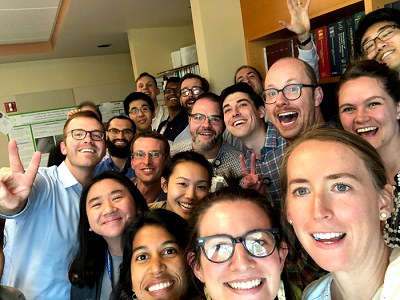
Overview
The three-week Social Medicine rotation is an integral component of the intern year of Internal Medicine residency at OHSU. This rotation offers a comprehensive blend of clinical and non-clinical experiences, all centered around serving vulnerable patients in the Portland community. Notably, the rotation expands beyond traditional settings like the VA or OHSU, providing a diverse range of opportunities "off the hill." Interns participate in experiences at Hooper Detox Center where patients undergo initial treatment and withdrawal support for use disorders, Central City Concern where patients with socioeconomic and housing barriers receive care in downtown Portland, Home-Based Primary Care visits to patient homes through the VA, community volunteer experiences to help expose residents to local community resources, Bridges Clinic time at the student-run clinic for adults in houseless shelters, and narrative medicine activities which provide space for reflection. In addition, interns receive mentored and supported time to conceptualize an advocacy project for a community and topic that is meaningful to them.
In addition to the hands-on learning outlined above, there are asynchronous learning materials that include comprehensive addiction management and buprenorphine training, activities that explore implicit bias and systemic racism, and reflection and reading about the impacts that poverty has on the health of our patients. By allowing time for asynchronous learning and guided exercises designed to empower early physicians, the rotation shows residents that they can make a meaningful impact in shaping the future of our profession and the overall health of our communities.
Goals
- To expand your sociocultural awareness and appreciation for the impact of the social and structural determinants of health in our community and country
- To provide you with the skills and capacity to feel empowered to address health system and social system gaps, including through the following:
- Reflecting more deeply on your own role and professional development as a physician advocate
- Strengthening your ability to take multiple perspectives
- Practicing skills in advocacy
- To deepen your understanding of the impact of structural racism in medicine, health care and our society, and its impact on health for individuals and populations
- To improve knowledge, skills, and attitudes toward health and health care for vulnerable populations
- To better understand addiction and addiction treatment options that are both generalizable and specific to the Portland community
- To allow additional time in continuity clinics that more closely mimic the experience of primary care
Kaiser Permanente Rotation
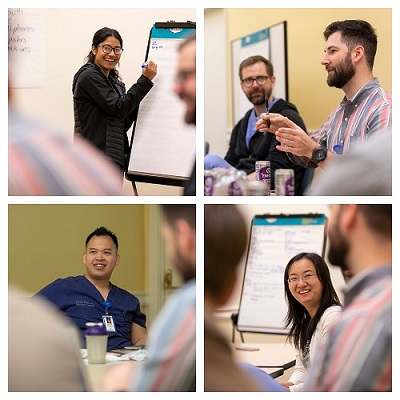
In the second and third years, residents rotate with the ambulatory clinics in the local Kaiser Permanente in the Portland area. The two-month rotation is an opportunity to experience both primary care and ambulatory specialty care in a large non-government integrated HMO setting, different from experiences at the VA and the University. Residents are given increasing levels of autonomy in management of outpatient cases in the primary care clinics where they enjoy continuity with a small group of physician preceptors. Residents can express a preference in their subspecialty experiences, and a week in the urgent care clinic provides further opportunity for procedures like suturing and injections as well as management of acute injuries. Third year residents are also given an option for a two-week hospitalist rotation as an opportunity to contrast experiences at the VA and the University.
The rotation includes two conference series. The first of these is the Health System Curriculum, a collection of topics relevant to current ambulatory practice such as healthcare economics, current government legislation, advanced care planning, Death with Dignity, quality improvement projects in practice, and personal financial wellness. The second conference series includes topics relevant to the current practice of primary care such as headache management, chronic kidney disease, recreational use of marijuana, diet and weight loss. With only eight residents per rotation block, these conferences are conducted as small groups, allowing for engaged learning. Within this small group, residents share ambulatory case presentations and discuss medicine in the lay media.
Finally, the third-year residents complete a self-designed and self-directed independent investigation or quality improvement project over the course of the rotation. This is often a highlight of the rotation. Recent topics have included: the intersection of reproductive rights and cardiovascular health, healthcare systems and delivery issues with TAVR, and reimagining memory care.
The Kaiser rotation is frequently described as a unique and novel ambulatory experience that allows residents to visualize outpatient practice in a different way. Over the last few decades, many of our graduates choose to work at Kaiser after residency – and many of them choose to teach and precept our OHSU Internal Medicine residents.
The OHSU and VAMC offer subspecialty consultation rotations (“selectives”) in Cardiology, Endocrinology, Gastroenterology, Hematology/Oncology, Infectious Diseases, Nephrology, Palliative Care, Pulmonary, and Rheumatology. Over the course of 3 years, residents will rotate on almost all of these “selectives”, with assignments based on resident preferences. When on subspecialty consultation services, residents participate in the clinics, conferences, and consulting rounds of those subspecialties, working closely with the faculty and fellows. The residents play a central role in the consultation component of those disciplines, but also have opportunities to develop related procedural skills. Senior medical students on subspecialty electives often work with the consulting residents.
Most consult rotations are 1-3 weeks in duration. The number of weeks is determined by scheduling and personal needs. If you are scheduled on a consult rotation for 2 or more weeks, you may be asked to work the weekend in-between. There are no continuity clinics during consults, which results in residents being more fully present, thereby enhancing continuity of care and increased teaching and consistency of presence for the team.
In addition, rotations in Neurology and Geriatrics are provided throughout training. The neurology rotation is available at OHSU Hospital and is usually done in the PGY-1 year. Interns on this service work alongside the Neurology housestaff and are supervised by Neurology faculty. The Geriatrics rotation is also based at OHSU, with interns rotating at one of the two local (SNF/LTC) facilities; Mirabella Portland or Holladay Park Plaza. The overarching goal of this rotation is to expose trainees to the skilled-nursing and long-term care settings in which their older adult patients reside. Interns will learn principles of geriatric medicine and common geriatric syndromes, models of geriatric care including rehabilitation and nursing home structures, transitions of care, and interprofessional team care within the skilled nursing facility (SNF) and long-term care (LTC) settings.
Electives for IM Residents
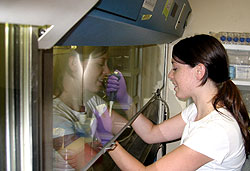
Internal medicine residents at OHSU are assigned an elective block during their PGY-2 and PGY-3 years of training. Residents may choose to fill this time with either local or national clinical or research experiences, or with an international clinical experience in Botswana.
- PGY-2 residents receive a total of 5 elective weeks broken apart into a 2-week block and a 3-week block
- PGY-3 residents receive a total of 3 elective weeks scheduled in one 3-week block
- Residents participating in the Botswana rotation receive a total of 4 elective weeks
On-Campus Opportunities
On-campus elective opportunities range from general internal medicine and sub-specialty consult experiences to rotations in other OHSU or affiliate departments (such as radiology or orthopedics). Many residents who are pursuing sub-specialty training will decide to use their elective month to conduct research. Faculty from each Medicine sub-specialty are available for current residents to serve as research contacts and mentors. Residents have been extremely successful in their research endeavors, often presenting at national meetings.
Off-Campus Opportunities
Off-campus opportunities include a wide variety of options. Some residents choose to take advantage of OHSU IM residency alumni, and travel to other states to complete clinical electives in unique health care environments such as the Indian Health Service. Local off-campus opportunities are also available at Virginia Garcia Memorial Health Center, a Federally Qualified Health Center with a special emphasis on migrant and seasonal farmworkers and others with barriers to receiving care. Additionally, a number of residents have used elective time for an international experience to hone clinical skills and develop language skills, as well as to lay groundwork for research opportunities. For those wanting an international experience, we currently partner with Beth Israel Deaconess Medical Center to offer a unique and challenging elective in Botswana.
Research
Residents have an opportunity to participate in research activities during their elective rotations and at other times during their training. Residents may choose to work with faculty at OHSU or the Portland VA Medical Center or go off-campus (local and abroad).
Over the years, residents have completed projects that led to abstract presentations at national society meetings and subsequent publications. In the past several years, residents have presented papers at the AFCR, the International AIDS meeting, the American Gastroenterology Association, American Society of Microbiology (ICCAC) and the American College of Physicians national meetings and have won national abstract competitions sponsored by the American College of Physicians.
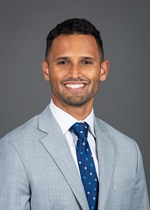
Nilan Schnure, MD
Assistant Professor of Medicine
Co-Director of Ultrasound Education, Internal Medicine Residency
Director, Internal Medicine Ambulatory Point-of-Care Ultrasound
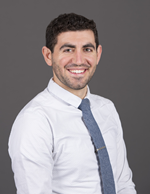
Aaron Silver, MD
Assistant Professor of Medicine
Co-Director, Internal Medicine Ultrasound Education
Director, Point-of-Care Ultrasound Continuity Elective
Division of Hospital Medicine, OHSU
Additional IM POCUS Core Faculty (not pictured): Lokesh Yadav, MD and James Anstey, MD
“Tell me, I forget; show me, I remember; involve me, I understand.”
Point-of-Care Ultrasound (POCUS) is a patient-centered, powerful tool to aid diagnostic evaluation, sharpen clinical decision-making, monitor therapies, guide procedures, and reinforce patient understanding. OHSU Internal Medicine faculty and residents have been at the forefront of advancing POCUS through research, innovation, and national leadership in education. OHSU is one of the few institutions offering a dedicated fellowship in general medicine POCUS after residency, giving our residents exceptional access to diverse learning and mentorship opportunities. Our cutting-edge clinical POCUS workflow allows residents to save images, receive feedback from an attending, and add documentation and images to the patient chart. This supports residents in creating a portfolio of images throughout residency – valuable for both career development and patient care.
Intern Intensive POCUS Workshop
All OHSU IM PGY-1s participate in two half-day workshops covering basic cardiopulmonary and abdominal ultrasound. These sessions combine didactics with hands-on scanning of standardized patients in a low-stakes, interactive environment. Faculty-led case-based discussions illustrate how POCUS can guide the care of common problems, such as acute kidney injury and hypotension – building a strong foundation for clinical application.
Friday POCUS Rounds
Each week, General Medicine University wards teams – students, residents, attendings, and a POCUS expert – gather to review images acquired on their own patients. These sessions focus on image optimization, interpretation, clinical integration, and evidence review. This innovative format fosters longitudinal learning and spaced repetition in a real-world clinical environment.
Internal Medicine Ultrasound Elective
Residents seeking an immersive experience may choose a 1-, 2-, or 3- week individualized POCUS elective. This includes practice on a state-of-the-art cardiopulmonary simulator, bedside training with faculty and IM Ultrasound fellows, and participation in weekly ultrasound conferences. Residents practice on the medical wards and receive feedback on their images. There are also opportunities for specialized experiences such as ICU scanning, shadowing echocardiographers, or sessions in a musculoskeletal outpatient clinic.
POCUS Pathway
Residents aiming for POCUS proficiency may apply for the “POCUS Pathway” that starts during the PGY-2 year. This program offers monthly hands-on scanning sessions, dedicated conferences, and image portfolio development with formative feedback. Pathway participants receive longitudinal mentorship from General Medicine Ultrasound Fellows and POCUS faculty, with the goal of graduating fully entrusted to perform POCUS in clinical care and to be a leader in future POCUS education.
